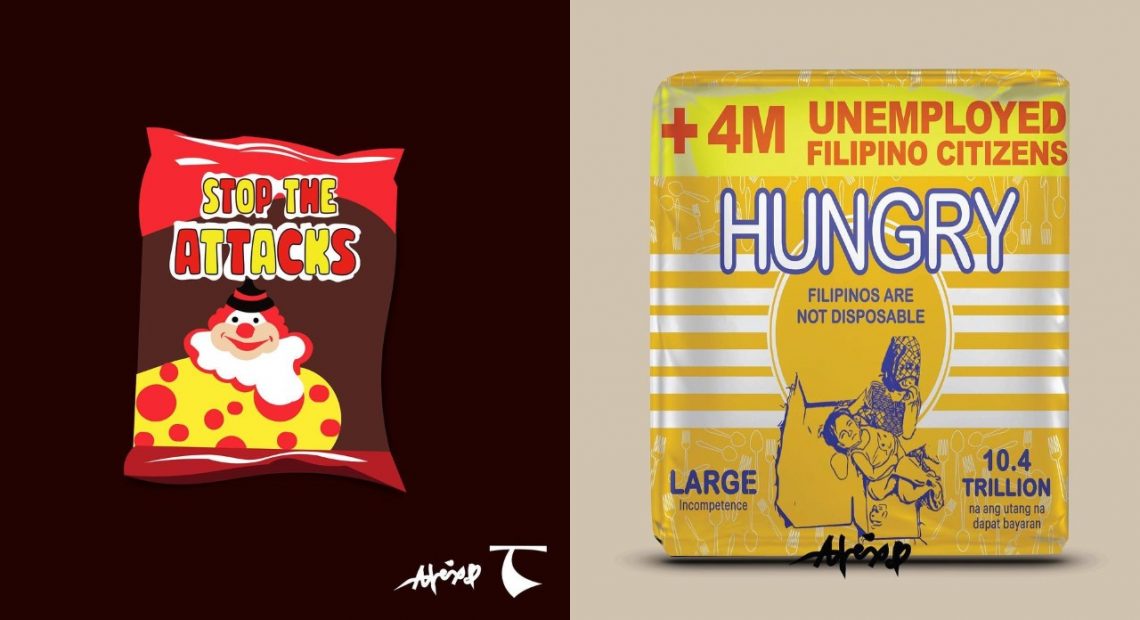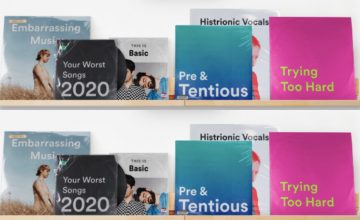Like the activists who take to the streets, protest art finds its roots in the urban outdoors, as seen in the spray-painted walls quickly shrugged off as vandalism, or the effigies burned to nothing during SONA season. Protest art, like the uttered kind, needs an audience. And here, art is their soapbox.
But in the age where time is spent in front of screens, other mediums have emerged. Twenty-year-old student leader Alex Brotonel is one partaking in this. If the ghost of pop art’s past had Warhol’s soup can and its ironic take on consumerism, Alex’s digital works of dissent against systematic oppression take the form of products we glance at on the daily, from potato chip packaging to film posters, all bearing her messages.
View this post on Instagram
Aside from helming her college batch’s student organization as president, Alex creates art that takes a stand for marginalized sectors in the most digestible way, with all of her commissions’ proceeds donated to them. “Protest art does not have to be complicated or difficult to understand,” she tells us. “Instead, it should validate and serve as a reflection of the everyday struggles our fellow Filipinos experience due to the inefficiency of those in power. For me, I see my art as a medium that sides with ordinary Filipino citizens and will continuously stand for their rights.”
View this post on Instagram
With her portfolio of unapologetically facetious editions of everyday products, Alex is among the young artists reshaping local protest art as we know it. We talk to the artist about her choice of medium, the fear of young activists in today’s political climate, and the lasting impression she hopes to make.
Why did you decide to use everyday pop culture-related products as a medium for protest art?
Activism—especially in today’s political climate—can be very intimidating and scary. However, I believe that using these kinds of products as my references will allow my art to be more relatable. Kahit mayaman ka o mahirap, matanda o bata, maiintindihan mo kung ano ’yung ipinaglalaban ko. (Whether you’re rich or poor, old or young, you’ll understand what I’m fighting for.)
View this post on Instagram
It’s a turbulent time as young people are getting red-tagged for helping and speaking out. What inspired you to create socio-political art despite this?
I think what inspired me the most are the people of our country. I cannot put into words how difficult it is for me to stay in my own privileged bubble and choose to stay blinded by all that’s been happening. Ang dami nating kababayan na nagugutom, nawalan ng hanapbuhay, walang akses sa kalidad na edukasyon, namatayan ng mga kapamilya at walang bubong na sinisilungan. (There are a lot of people in our country who are living in hunger, who have lost their livelihoods, who have no access to quality education, who have lost loved ones, and who have no homes.)
If my protest art sparks an initiative for more individuals to stand with these people, bakit ako titigil (why would I stop)? I admit, red-tagging is indeed scary, but I am at peace knowing that my only intention in creating these types of art is to amplify the calls for accountability, justice, and good governance.
View this post on Instagram
As an artist, have you always been drawn to discussing issues like these?
Creating protest art is a choice I make every day. Every day, you would have to wake up with the same purpose, to stand with the Filipino masses. Kasi kung hindi ako ang titindig para sa kanila, sino ang maglalakas loob? (If I don’t stand up for them, who’d be willing to do it?)
To be honest, I never saw myself in this kind of field. Back in 2017, I started drawing for mental health awareness but now I draw for the oppressed, manipulated, and abused. And until now, I still try to experiment with different styles to find out what is the most effective way to get my messages across. Kasi ’yun ’yung kailangan ko, maiparating sa maraming Pilipino ang aking ipinaglalaban. (What I need is to bring my advocacies’ messages across to many Filipinos.)
Every day, you would have to wake up with the same purpose, to stand with the Filipino masses. Kasi kung hindi ako ang titindig para sa kanila, sino ang maglalakas loob?
Do artists have a responsibility to create work that reflects their society today? For you, is art inherently political?
Well, art is used for expression, but as we grow old, a lot of people say otherwise. Some people say that art should be pragmatic, technical, and should follow a certain style. A lot of people believe that great artworks belong in galleries. But art in protest tells us otherwise. Protest art aims to communicate with its audience. It aims to validate the struggles of the people who are continuously fighting against oppression and abuse. I may never see my art in museums and galleries, but I am hopeful that my art can spark a conversation.
View this post on Instagram
What do you hope viewers would take away after viewing your works?
I personally do not expect my viewers to create protest art too. Pero, sana may maitanong nila sa kanilang mga sarili, “May magagawa ba ako para mapabuti kahit papaano ang buhay ng aking mga kababayan?” (But, I hope it can prompt them to ask themselves, “What can I do that’ll benefit the lives of my fellow citizens?”)
Through this, I hope my viewers can develop their own stances and choose to act [on] what they believe in. You can create your own change without creating protest art. Maraming paraan kung paano sila makakatulong, at kapag sila’y handa nang umaksyon, andito ako para sabayan sila sa pagbuo ng pagbabago. (There are a lot of ways that they can help, and if they’re ready to take action, I’m here to join them to help make change happen.)
Read more:
A virtual exhibit made by students calls for a better pandemic response
This art student transformed canned goods into protest statements
MAKÔ Collective fights the system through zines
Art by Alex Brotonel

























Comments